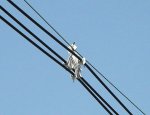mbrooke
Batteries Included
- Location
- United States
- Occupation
- Technician
When I was a kid in Philadelphia I saw a live wire on the ground melt insulation and leave burn marks in the concrete. It also jumped up and down when they would reclose the switch, so even if it is off, it may come back on with a automatic reclosure.
Very true, even worse with automatic loop schemes.


